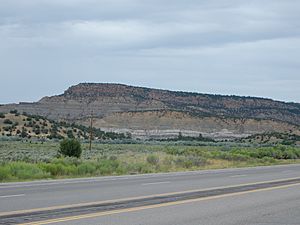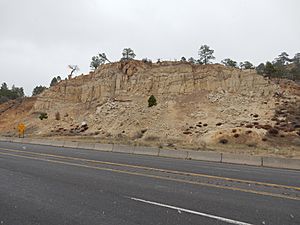San Jose Formation facts for kids
Quick facts for kids San Jose FormationStratigraphic range: Wasatchian ~55.8–50Ma |
|
|---|---|

San Jose Formation capping Mesa de Cuba, northern New Mexico
|
|
| Type | Formation |
| Sub-units | Cuba Mesa, Ditch Canyon, Llaves, Regina & Tapicitos Members |
| Overlies | Nacimiento Formation |
| Thickness | 430 m (1,410 ft) |
| Lithology | |
| Primary | Sandstone |
| Other | Shale |
| Location | |
| Coordinates | 36°17′N 107°04′W / 36.29°N 107.06°W |
| Approximate paleocoordinates | 41°12′N 91°42′W / 41.2°N 91.7°W |
| Region | New Mexico |
| Country | |
| Extent | San Juan Basin |
| Type section | |
| Named for | San Jose Valley (36°10′48″N 106°55′37″W / 36.180°N 106.927°W) |
| Named by | G.G. Simpson |
| Year defined | 1948 |
The San Jose Formation is a special layer of rock found in New Mexico and Colorado. It formed a very long time ago, during a period called the Early Eocene epoch. This was about 50 to 55 million years ago! Scientists study this rock layer to learn about Earth's past.
Contents
What is the San Jose Formation?
The San Jose Formation is mostly made of sandstone, which is rock formed from sand. It also has some layers of mudstone, which is rock formed from mud. Imagine a wide, flat area with many rivers flowing through it. This area was a muddy floodplain, and the San Jose Formation formed from the sand and mud left behind by these ancient rivers.
The rivers flowed from the northwest, north, and east, heading towards the south. Over millions of years, these layers of sand and mud hardened into the rock we see today.
Layers of the Formation
The San Jose Formation is divided into several smaller parts, called "members." Each member tells a slightly different story about how the land changed.
- The Cuba Mesa Member is at the bottom. It's a thick layer of coarse, sandy rock found all over the area. It formed when the center of the basin was sinking.
- The Regina Member is mostly muddy rock from the floodplain. It also has some sandy layers.
- The Ditch Canyon Member (in the northwest) and the Llaves Member (on the east) are mostly sandstone. They mix with the Regina Member.
- The Tapicitos Member is the top layer. It's mostly siltstone, which is a rock made from very fine sand or mud.
These upper layers formed as the land was pushed up and folded along a large crack in the Earth called the Nacimiento Fault.
Ancient Life: Fossils in the San Jose Formation
The mudstone layers in the San Jose Formation are like treasure chests filled with fossils! These fossils help scientists understand what life was like during the Early Eocene. They include animals from the "Almagre" and "Largo" groups, which are names for collections of fossils from that time.
Amazing Fossil Discoveries
Many different types of ancient animals have been found here. Imagine what these creatures looked like roaming the ancient floodplains!
Ancient Mammals
- Primates
- Copelemur tutus
- Cantius angulatus
- C. frugivorus
- Microsyops angustidens
- M. latidens
- Omomyidae indet.
- Artiodactyls (Hoofed Mammals)
- Bunophorus grangeri
- Diacodexis cf. metsiacus
- Simpsonodus chacensis
- Carnivora (Meat-Eaters)
- Vulpavus australis
- Cimolesta
- Esthonyx bisulcatus
- Ferae
- Ambloctonus sinosus
- Oxyaena lupina
- O. simpsoni
- Glires (Rodent-like Mammals)
- Knightomys depressus
- K. reginensis
- Paramys copei
- P. nini
- Hyaenodonta
- Insectivora (Insect-Eaters)
- Apatemys bellulus
- Pantodonta
- Coryphodon armatus
- Perissodactyla (Odd-Toed Hoofed Mammals)
- Eohippus angustidens
- Systemodon tapirinus
- Xenicohippus osborni
- Placentalia
- Copecion brachypternus
- Hyopsodus lysitensis
- Hyopsodus cf. mentalis
- Hyopsodus minor
- Meniscotherium chamense
- M. tapiacitum
- Hyopsodus sp.
- Taeniodonta
- Ectoganus gliriformis
- Theriiformes
Ancient Reptiles
- Snakes
- Cheilophis huerfanoensis
- Saniwa ensidens
- Sanjuanophis froehlichi
- cf. Calamagras primus
- cf. Saniwa sp.
- Turtles
- Baena arenosa
- Baptemys garmanii
- Echmatemys lativertebralis
- Hadrianus majusculus
- Planetochelys dithyros
- Trionyx leptomitus
- Baltemys sp.
- Chelydridae indet.
- Trionychidae indet.
- Lizards
- Paraglyptosaurus cf. yatkolai
- Lacertilia indet.
How Scientists Discovered the San Jose Formation
The story of the San Jose Formation began in 1874 with a scientist named Edward Drinker Cope. He was part of a survey team exploring New Mexico. Instead of following his orders, he decided to explore an area where people had reported finding fossils.
Cope found amazing Early Eocene fossils in the badlands near Regina, New Mexico. He spent about seven weeks collecting ancient fish, reptiles, and what were then the oldest known mammal fossils in North America! He even found the fossil of a giant bird that couldn't fly. Cope was so excited that he wrote to his father, calling it "the most important find in geology I have ever made."
Many years later, in 1948, another famous scientist named George Gaylord Simpson visited the same area. He was the one who officially named these fossil-rich rock layers the San Jose Formation. Later, in 1967, scientists further divided the formation into its different members, like the Cuba Mesa and Regina Members, to better understand its history.


